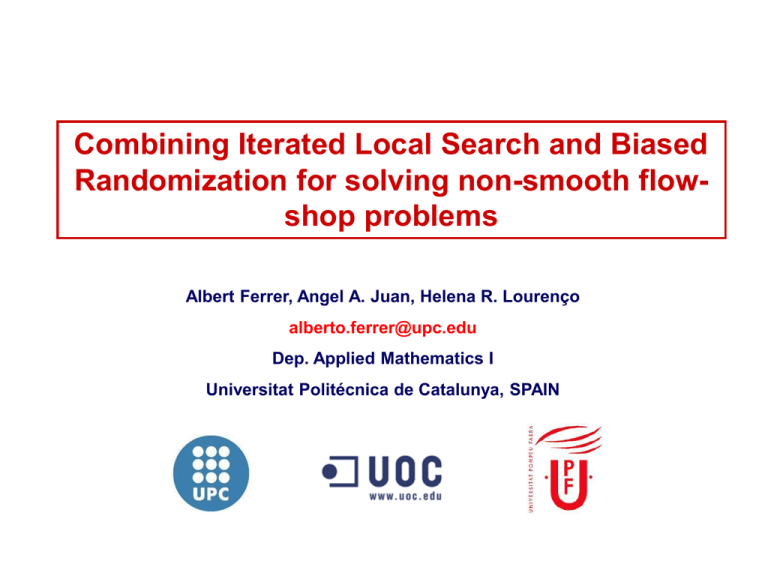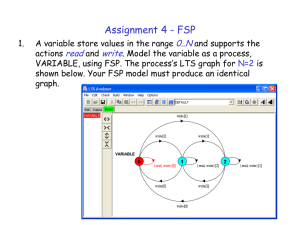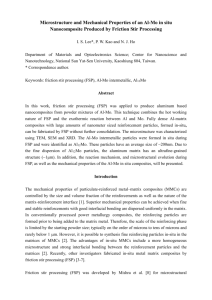The Flow-Shop problem - DPCS@IN3-UOC
advertisement

IEMAE
Combining Iterated Local Search and Biased
Randomization for solving non-smooth flowshop problems
Albert Ferrer, Angel A. Juan, Helena R. Lourenço
alberto.ferrer@upc.edu
Dep. Applied Mathematics I
Universitat Politécnica de Catalunya, SPAIN
Overview
1. Convex Optimization Problems (COPs)
2. Non-Convex Optimization Problems (NCOPs)
3. Non-Smooth Optimization Problems (NSPs)
4. The Flow-Shop problem (Makespan)
5. The NEH heuristic for FSP
6. The ILS-ESP algorithm for FSP
7. Randomizing Classical Heuristics
8. A More Realistic Model for FSP (Tardiness)
9. Conclusions and Future Work
Overview
1. Convex Optimization Problems (COPs)
2. Non-Convex Optimization Problems (NCOPs)
3. Non-Smooth Optimization Problems (NSPs)
4. The Flow-Shop problem (Makespan)
5. The NEH heuristic for FSP
6. The ILS-ESP algorithm for FSP
7. Randomizing Classical Heuristics
8. A More Realistic Model for FSP (Tardiness)
9. Conclusions and Future Work
Overview
1. Convex Optimization Problems (COPs)
2. Non-Convex Optimization Problems (NCOPs)
3. Non-Smooth Optimization Problems (NSPs)
4. The Flow-Shop problem (Makespan)
5. The NEH heuristic for FSP
6. The ILS-ESP algorithm for FSP
7. Randomizing Classical Heuristics
8. A More Realistic Model for FSP (Tardiness)
9. Conclusions and Future Work
Overview
1. Convex Optimization Problems (COPs)
2. Non-Convex Optimization Problems (NCOPs)
3. Non-Smooth Optimization Problems (NSPs)
4. The Flow-Shop problem (Makespan)
5. The NEH heuristic for FSP
6. The ILS-ESP algorithm for FSP
7. Randomizing Classical Heuristics
8. A More Realistic Model for FSP (Tardiness)
9. Conclusions and Future Work
1. Convex Optimization Problems (COPs)
COPs are problems where all of the
constraints are convex functions, and the
objective is a convex function if minimizing, or
a concave function if maximizing.
Linear functions are convex, so LP problems
are COPs.
In
a
COP,
the
feasible
region
A convex function
LPs are COPs
–the
intersection of convex constraint functions–
is also a convex region.
With a convex objective and a convex
feasible region, each optimal solution is
globally optimal.
Several methods –e.g.
Interior Point methods– will either find the
globally optimal solution, or prove that there
is no feasible solution to the problem.
A convex region
COPs can be solved efficiently up to very
large size.
Source: www.solver.com
2. Non-convex Optimization Problems (NCOPs)
A non-convex function with multiple local minima
NCOPs are problems where either
the objective or any of the
constraints are non-convex.
NCOPs may have multiple feasible
regions and multiple locally optimal
points within each region.
It can take exponential time in the
number of variables and constraints
to determine that a non-convex
problem is infeasible, that the
objective function is unbounded, or
that an optimal solution is the
"global optimum" across all feasible
regions.
Non-convex
regions
Source: www.solver.com
3. Non-Smooth Optimization Problems (NSPs)
Typically, NSPs are also NCOPs. Hence:
Examples of non-smooth functions
They might have multiple feasible regions and
multiple locally optimal points within each
region –because some of the functions are
non-smooth or even discontinuous, and
Derivative/gradient
information
generally
cannot be used to determine the direction in
which the function is increasing (or
decreasing).
In a NSP, the situation at one possible
solution gives very little information about
where to look for a better solution.
In most NSPs it is impractical to enumerate
all of the possible solutions and obtain the
best one. Hence, most methods rely on some
sort of random sampling of possible solutions.
Such methods are nondeterministic or
stochastic –they may yield different solutions
on different runs, depending on which points
are randomly sampled.
Source: www.mathworks.com
3. Examples of Nonsmooth Functions
The Problem
Sensor Network Localization
Optimal Circuit Routing
Winner Determination Problem
The objective function
4. The Flow-Shop problem (1/2)
The Permutation Flowshop Sequencing
Problem (PFSP) is a well-known
scheduling problem that can be
described as follows:
A set J of n independent jobs has
to be processed on a set M of m
independent machines.
Jobs are processed
by machines
machine
...
machine
Already
processed jobs
Jobs to process
Every job j in J requires a given
fixed processing time pij > 0 on
every machine i in M.
Each machine can execute at most
one job at a time.
All jobs are processed by the
machines in the same order.
Classical goal: to find a sequence for
processing the jobs in the shop so that
the completion time or makespan is
minimized.
Goal: To find the sequence of jobs that
minimizes the makespan
4. The Flow-Shop problem (2/2)
The PFSP is a combinatorial problem
with n! possible sequences which, in
general, is NP-complete.
A large number of different approaches
have been developed: from pure
optimization methods (e.g. mixed
integer programming) to the use of
heuristics and metaheuristics.
Still, there is a need for new efficient,
simple and parameter-free (ESP)
methods able to provide a large set of
alternative near-optimal solutions with
different properties, so that decisionmakers can choose among different
alternative solutions according to their
specific necessities and preferences.
Metaheuristics
Utility function
5. The NEH heuristic (Nawaz et al. 1983)
Calculate
the
total
processing time required
for each job, and then to
create an “efficiency list”
of jobs sorted in a
descending order
At each step, the job at
the top of the efficiency
list is selected and used
to construct the solution.
Once selected, a job is
inserted in the sorted set
of
jobs
that
are
configuring the ongoing
solution.
The
exact
position that the selected
job will occupy in that
ongoing solution is given
by
the
minimizing
makespan criterion.
NEH is probably the most efficient heuristic for the PFSP
Job i
For each job, calculate
its total processing time
Job 1
Job 2
…
Construct a sorted efficiency list
(jobs with higher processing times at the top)
Job n
At each iteration,
select the job at
the top of the list
Job 3
Job 1
Each new job is
inserted into the “best”
possible position
Job 2
6. The ILS-ESP algorithm
The ILS-ESP is based
on the IG-ILS (Ruiz
2007). It is equally
Efficient, Simpler and
Parameter-free.
It incorporates 3 major
changes with respect
to IG-ILS: (1) the
RandNEH
method,
which
provides
diversification in the
initial solution, (2) a
new ‘enhanced swap’
operator, and (3) a
simpler Demon-based
acceptance criterion.
ILS-ESP is an efficient, simple and parameter-free algorithm for the PFSP
0 parameters
Iterated Local Search framework
Randomized NEH solution
Enhanced Swap operator
Demon-like acceptance criterion
We have tested ILS-ESP vs. IG-ILS using the Taillard benchmarks (120 instances) and they
seem to offer equivalent performance: Average GAP = 0.36% in 10ms*nJobs*nMachines
and after running each algorithm 10 times (replicas).
7. Randomizing Classical Heuristics
This
way,
deterministic
classical
heuristics (e.g.: Clarke and Wright, NEH,
etc.) are transformed into probabilistic
ones without losing the “common sense”
rules that make them efficient.
Thus, we transform a “gun heuristic”
into a “machine-gun heuristic”: each
time the randomized heuristic is run, a
different “good” solution will be
obtained (kind of a “Biased GRASP”).
The geometric and the discrete version
of the triangular can be used to infer
this BRB.
Distribution Plot
Geometric
p
0.1
0.2
0.20
Geometric
distributions
0.15
Probability
We propose to introduce a biased
random behavior (BRB) in the selection
processes of classical heuristics so that
movements with better values have
higher probabilities of being selected, but
other movements could also be selected
instead at each step.
0.10
0.05
0.00
0
10
20
30
40
X
X = total number of trials.
Triangular
distributions
50
8. RandNEH: Randomizing the NEH for the PFSP
NEH jobs are ordered in decreasing order according to their total completion
time on all the machines
RandNEH introduces randomness in this process by using a triangular statistical
distribution jobs that take longer to complete will be more likely to be selected
first, but all jobs in the list are potentially eligible.
Notice: Each time RandNEH is run, a different random solution is obtained. By
construction, chances are that this solution outperforms the NEH one and, in any
case, this solution will be a good alternative to the original NEH diversification
of the starting base solution.
Chart of C2
600
500
Generating triangular random variates
•
Calculate u ~ U(0,1)
•
Calculate X = b * (1 – Sqrt(1 – u))
•
Calculate pos = Floor(X)
Count
400
300
200
100
0
0
1
2
3
4
5
6
7
8
9 10 11 12 13 14 15 16 17 18
C2
9. The Enhanced Swap & the Acceptance Criterion
New Enhanced Swap operator:
1.
Select two positions at
random.
2.
Interchange jobs at the
selected positions.
3.
Perform a sorted ‘shift-toleft’ movement to ‘adjust’
the positions of the
swapped jobs.
New acceptance criterion:
1.
If the new solution improves the best
solution, then update base solution
(improvement).
2.
Else, accept the new solution as the base
solution (degeneration) as far as the last
movement was an improvement and the
degeneration is not greater than the last
improvement.
10. The Flow-Shop Problem: Some results
1.
Test: 15 runs per instance with maxTime = 0.010s * nJobs * nMachines
2.
Computer: Intel Xeon 2.0GHz 4GB RAM
3.
Note: All algorithms have been implemented in Java (non-optimized code)
Juan, A.; Ruiz, R.; Mateo,
M.; Lourenço, H.; Ionescu,
D. (2010): “A Simulationbased
Approach
for
Solving the Flowshop
Problem”. In Proceedings
of
the 2010 Winter
Simulation Conference.
11. FSP: A More Realistic Model
The following notation is used for the description of the flow-shop problem:
12. FSP: Objective Function
13. FSP: The Model
14. FSP in production industries
1. Most of the flow-shop problems arise in production industries, where a set of
products or jobs must be produced.
14. FSP in production industries
1. Most of the flow-shop problems arise in production industries, where a set of
products or jobs must be produced.
2. These industries usually are integrated in a supply chain, meaning that after
being produced they are transported to a warehouse or customers.
14. FSP in production industries
1. Most of the flow-shop problems arise in production industries, where a set of
products or jobs must be produced.
2. These industries usually are integrated in a supply chain, meaning that after
being produced they are transported to a warehouse or customers.
3. Usually this transportation is set in advance and it has a periodicity, for
example every 2 hours or morning and afternoon.
14. FSP in production industries
1. Most of the flow-shop problems arise in production industries, where a set of
products or jobs must be produced.
2. These industries usually are integrated in a supply chain, meaning that after
being produced they are transported to a warehouse or customers.
3. Usually this transportation is set in advance and it has a periodicity, for
example every 2 hours or morning and afternoon.
4. In this case the due date is related with this transportation schedule, a job
is produced on time if it can meet its transportation due date, and if it late the
jobs must be scheduled to later transport.
15. FSP transportation scheduled
•
The commercial agents negotiate the date, d’j, that the job must be delivered to
the customer's location (delivery date ).
15. FSP transportation scheduled
•
The commercial agents negotiate the date, d’j, that the job must be delivered to
the customer's location (delivery date ).
•
Assuming that we have an estimated transportation time, ξj , between the
workshop and the customer, we can calculate the due date at the workshop,
dj = d’j - ξj. This assumes that exist a constant transportation to the customer
which is not usually the case.
15. FSP transportation scheduled
•
The commercial agents negotiate the date, d’j, that the job must be delivered to
the customer's location (delivery date ).
•
Assuming that we have an estimated transportation time, ξj , between the
workshop and the customer, we can calculate the due date at the workshop,
dj = d’j - ξj. This assumes that exist a constant transportation to the customer
which is not usually the case.
•
We assume that the transportation is scheduled every period of time, τ, that
is there are an available transportation at the times t0, t1, t2, … , with τ = tk-tk-1
15. FSP transportation scheduled
•
The commercial agents negotiate the date, d’j, that the job must be delivered to
the customer's location (delivery date ).
•
Assuming that we have an estimated transportation time, ξj , between the
workshop and the customer, we can calculate the due date at the workshop,
dj = d’j - ξj. This assumes that exist a constant transportation to the customer
which is not usually the case.
•
We assume that the transportation is scheduled every period of time, τ, that
is there are an available transportation at the times t0, t1, t2, … , with τ = tk-tk-1
•
Therefore, the job must be produced before the corresponding transportation
schedule time, tkj, which is the closest tk before the workshop due date dj,
tkj= max{ tk : tk <= dj}, otherwise the job can not arrive on time.
16. FSP penalizations
Different situations can occur:
16. FSP penalizations
Different situations can occur:
The job is completed on time, just before the correspondent transportation schedule,
tkj - τ < Cm,j <= tkj,
after being produced the jobs goes directly to the vehicle, and it is on time to me delivered
to the customer; so, there is no penalization for being early or late..
The job is completed too early, i.e., before the previous correspondent transportation
schedule,
Cm,j <= tkj - τ,
therefore the company has to store this job on a warehouse so there exist a penalization
related with the time that the product or job must be stored in the workshop. This cost
makes sense, since today most of the production companies have limited storing space.
The job is completed too late, i.e. after the correspondent transportation schedule,
Cm,j > tkj ,
therefore the job miss its corresponding transportation and it will be delivered late. In this
case we propose to types of penalization, by the time that the job is late and by the
number of periods that it is late.
16. FSP penalizations
Different situations can occur:
The job is completed on time, just before the correspondent transportation schedule,
tkj - τ < Cm,j <= tkj,
after being produced the jobs goes directly to the vehicle, and it is on time to me delivered
to the customer; so, there is no penalization for being early or late..
The job is completed too early, i.e., before the previous correspondent transportation
schedule,
Cm,j <= tkj - τ,
therefore the company has to store this job on a warehouse so there exist a penalization
related with the time that the product or job must be stored in the workshop. This cost
makes sense, since today most of the production companies have limited storing space.
The job is completed too late, i.e. after the correspondent transportation schedule,
Cm,j > tkj ,
therefore the job miss its corresponding transportation and it will be delivered late. In this
case we propose to types of penalization, by the time that the job is late and by the
number of periods that it is late.
16. FSP penalizations
Different situations can occur:
The job is completed on time, just before the correspondent transportation schedule,
tkj - τ < Cm,j <= tkj,
after being produced the jobs goes directly to the vehicle, and it is on time to me delivered
to the customer; so, there is no penalization for being early or late..
The job is completed too early, i.e., before the previous correspondent transportation
schedule,
Cm,j <= tkj - τ,
therefore the company has to store this job on a warehouse so there exist a penalization
related with the time that the product or job must be stored in the workshop. This cost
makes sense, since today most of the production companies have limited storing space.
The job is completed too late, i.e. after the correspondent transportation schedule,
Cm,j > tkj ,
therefore the job miss its corresponding transportation and it will be delivered late. In this
case we propose two types of penalization, by the time that the job is late and by the
number of periods that it is late.
17. FSP: Earliness and Tardiness
If a job is produced to early and must be stored to wait for the corresponding
transportation we have the following cost:
If a job is produced to late, it misses the corresponding transportation and
it is delivered late, the penalization cost is as follows:
In the case of a job being late, it is common practice to penalize by the
number of period that the job is late since if the job misses its transportation
must wait for the next one.
18. Conclusions & Future Work
We have discussed the use of probabilistic or stochastic algorithms for
solving non-smooth combinatorial optimization problems in the case of
FSP.
18. Conclusions & Future Work
We have discussed the use of probabilistic or stochastic algorithms for
solving non-smooth combinatorial optimization problems in the case of
FSP.
We propose the use of probability distributions, such as the Triangular
one, to add a biased random behavior to classical NEH heuristic for
the Flow Shop Scheduling Problem.
18. Conclusions & Future Work
We have discussed the use of probabilistic or stochastic algorithms for
solving non-smooth combinatorial optimization problems in the case of
FSP.
We propose the use of probability distributions, such as the Triangular
one, to add a biased random behavior to classical NEH heuristic for
the Flow Shop Scheduling Problem.
By randomizing these heuristic, a large set of alternative good
solutions can be quickly obtained in a natural and easy way.
18. Conclusions & Future Work
We have discussed the use of probabilistic or stochastic algorithms for
solving non-smooth combinatorial optimization problems in the case of
FSP.
We propose the use of probability distributions, such as the Triangular
one, to add a biased random behavior to classical NEH heuristic for
the Flow Shop Scheduling Problem.
By randomizing these heuristic, a large set of alternative good
solutions can be quickly obtained in a natural and easy way.
Some specific example in the makespan version of this technique have
been analyzed to illustrate the main ideas behind this approach.
18. Conclusions & Future Work
We have discussed the use of probabilistic or stochastic algorithms for
solving non-smooth combinatorial optimization problems in the case of
FSP.
We propose the use of probability distributions, such as the Triangular
one, to add a biased random behavior to classical NEH heuristic for
the Flow Shop Scheduling Problem.
By randomizing these heuristic, a large set of alternative good
solutions can be quickly obtained in a natural and easy way.
Some specific example in the makespan version of this technique have
been analyzed to illustrate the main ideas behind this approach.
An extension of the FSP that includes intermediary inventory holding
cost and the sum of earliness and tardiness has been described in
order to present a more realistic model (in progress).
IEMAE
Combining Iterated Local Search and Biased
Randomization for solving non-smooth flowshop problems
Thank You!
Albert Ferrer, Angel A. Juan, Helena R. Lourenço
alberto.ferrer@upc.edu
Dep. Applied Mathematics I
Universitat Politécnica de Catalunya, SPAIN







